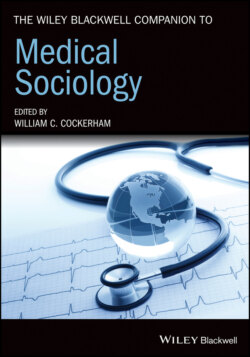Читать книгу The Wiley Blackwell Companion to Medical Sociology - Группа авторов - Страница 63
Culture and Sick-Role Behavior
ОглавлениеTo recapitulate what was discussed in the first section, sick-role behavior is the activity undertaken by a person who considers himself or herself ill for the purpose of getting well (based on Parsons 1951: 436–8). Sick-role behavior encompasses the sick person’s response to symptoms, in particular, the seeking of what he or she perceives as “technically competent” help (to borrow Parsons’ term), as well as doctor–patient or healer–patient interaction. Lyle Saunders (1954) was among the first sociologists to observe that cultural differences in medical care manifested in the problems encountered when the physician and the patient were from different ethnic groups.
One of the earliest and most significant investigations on the actual influence of culture on sick-role behavior was Mark Zborowski’s (1952, 1969) analysis of cultural differences in responses to pain. Investigating differences among war veterans warded in an American hospital, he observed that the Italian-American and Jewish-American patients differed significantly from the “old American” and Irish-American patients in their expression of pain and description of their symptoms. Zborowski proposed that cultural differences such as socialization, time-orientation, and the array of values outlining what is appropriate behavior in cultural communities explained the differences he observed among the four groups of patients. Similarly, Irving Zola (1966) analyzed how culture shapes the subjective perception of symptoms. His research confirmed Zborowski’s findings on the presence of cultural differences in perception of, and reaction to, symptoms and pain. Zola (1973, 1983) continued his probe into the impact of cultural differences on the doctor–patient relationship, the perception of illness, and the importance given to health matters in different cultural communities. Twaddle (1978) conducted an exploratory replication of Zborowski’s study, comparing 26 American married males who classified themselves as “Italian Catholics,” “Protestants,” and “Jewish.” Twaddle found that Parsons’ configuration of “sick role” varied among these groups. The relevance of cultural differences in responses to pain is well recognized and research on this important dimension continues. Some examples of findings on cultural differences are: Black Caribbean and White British cancer patients (Koffman et al. 2008); Saudi, Swedish and Italian patients with temporomandibular disorder (Al-Harthy et al. 2016); Japanese and British subjects’ pain tolerance (Robertson et al. 2017); and chronic back pain among English-speaking Punjabi and white British people (Singh et al. 2018).
Similarly, studies continue to confirm the impact of culture on the doctor–patient relation and, correspondingly, on patient outcomes. Nitcher (1994) observed the use of the traditional term “mahina ang baga” (weak lungs) by doctors and lay persons in the Philippines. Nitcher found that doctors used the term when diagnosing tuberculosis in an effort to spare the patient the social stigma of the disease. However, “weak lungs” is a very ambiguous term in everyday discourse; thus, the unintended consequence was a negative patient outcome. Nitcher states “the sensitivity of clinicians to [the] social stigma [of tuberculosis] is laudatory.” But he correctly points out that “the use of the term weak lungs has [serious] consequences” for public health because the diagnosis “weak lungs is not deemed as serious as TB” and thus people, especially the poor, do not comply with the prescribed treatment, which is a “six-month course of medication” (Nitcher 1994: 659).
A major direct implication of the concept of role is the symbolic, perceived or actual presence and agency of others. Sick-role behavior implies the presence of the healing expert (irrespective of what healing system is at work). A large body of research findings on the doctor–patient relationship has confirmed the relevance of culture. As expected, cultural similarities, such as physical appearance and language, among other characteristics, between doctor (or healer) and patient facilitate the relationship and increase the possibility of positive patient outcomes (Cockerham 2016:175–205; Kleinman 1980: 203–58). A note of caution, however: Similarities in culture do not secure success in the doctor–patient relationship. Many other aspects come into play, from ecological factors (e.g. Catalano 1989), to the differential understanding of metaphors (e.g. Glennon 1999), and structural features of the dyadic healer–patient relationship. Structural features – such as who is involved and how the interaction is conducted – vary across cultures. Haug and her colleagues (1995) found interesting differences in the manner in which the doctor-patient relationship develops in Japan and the US. Kleinman (1980: 250–310) shows how the direct involvement of the patient’s family transforms that dyadic relationship in some communities. Furthermore, patients’ subjective assessment of their interpersonal relationship with their healer may become as significant as “the technical quality” of the medical care they receive (Haddad et al. 1998).
Following the same premise on the significance of the presence of others, another important aspect of sick-role behavior is the availability of an informal social support network for the sick individual. The emotional, social, and instrumental support received from one’s informal network of family and friends tends to guide the attitudes and actions of the ill person before, during, and after consulting experts. Just as cultural variations are observed among sick people searching for help from healing experts (whether traditional or modern), the seeking of emotional and social support and the presence and quality of informal social support from family and friends also vary across cultures. Some examples are: the comparative study of Asian-American and Anglo-American women’s situations after breast cancer diagnosis (Kagawa-Singer et al. 1997); the systematic review of barriers to mammography screening (Miller et al. 2019); and the utilization of mental health services in Japan (Kikuzawa et al. 2019).
